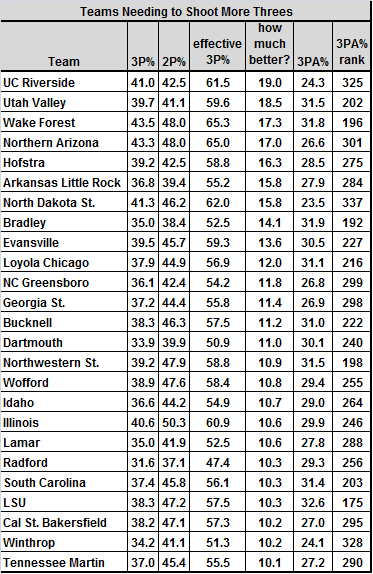Behind the Numbers: Who Needs to Shoot More Threes?
Posted by KCarpenter on December 22nd, 2010Kellen Carpenter is an RTC contributor.
A wise man was once asked why he shot so many threes. The sage stroked his chin and replied simply, “Because there are no fours.” Truly this is the wisdom of the ages. While there are some amongst us who dispute the wisdom-dispensing qualifications of former Kentucky Wildcat/Boston Celtic/Miami Heat Antoine Walker, there is at least a hint of a whiff of a smidgen of truth to his sentiment. The three is a powerful and deadly offensive weapon and the proper deployment of judicious three-point shooting can transform a tough team into a deadly team. This isn’t a secret. Lots of teams know this. How many March upsets follow the familiar script of an overmatched, smaller team launching a barrage of threes in a bid to upset its major-conference opponent? Most of them. But it’s not just underdogs that utilize the three, it’s the top dogs too: Duke’s tremendous early season success is due in no small part to shooting a blistering 43.6% from beyond the arc so far this season. The three is potent, indeed.
Yet, for some reason, many teams shy away from the three. Why? The three is mighty, and sometimes a player or a whole team can become drunk on its power, letting loose a barrage of deep shots only to have the shots not fall. The barrage of bricks, airballs, and just plain ugly shots can grind an offense to a halt. Fairly or not, some coaches disparage the three and discourage their players from taking what they see as a relatively low-percentage shot. In their eyes, the three is imprudent and hasty, the product of players not having the discipline to work the ball around the defense, to set up a shot closer to the rim for a “high-percentage shot.” It’s hard to fault coaches for wanting their teams to take the best shots they can get, but sometimes, in trying to avoid the risk of the three-point shot, coaches are actually turning down the real “high-percentage shot.”
Three-point shots, as you may have noticed, are worth one point more than a regular field goal, and because of this mathematical fact, hitting two out of five three-pointers or hitting three out of five standard field goals nets you the same result: six points on five shots taken. Dazzling arithmetic, I know, but I just want to be crystal clear on this so I can make the point that it’s easy to compare the relative efficacy of shooting twos versus shooting threes by simply taking the three-point shooting percentage of a given player or team and multiplying it by 1.5. This is the essential wizardry behind the concept of effective field goal percentage (eFG%) and the trick we are going to use to figure out which teams would be better off shooting more often from behind the arc.
If a team’s actual two-point field goal percentage is lower than the three-point field goal percentage multiplied by 1.5, it suggests that the team’s better offensive option is shooting the three. If you were to run this basic check on all 345 teams that Mr. Ken Pomeroy quantifies, you’d see that a whopping 246 teams get more offensive bang for their buck from shooting threes. Now, this is a really crude calculation with an even cruder suggestion: if you are effectively better at shooting threes than shooting twos (which most of you are) you should take more threes. This advice ignores a lot of variables like which shots are open, who is open to take those shots, and the difficult-to-measure value of a balanced offense. In many cases, coaches realize how valuable the three-point shot is and are taking those shots at a rate that they feel is most effective for their offense. In these cases, it’s not inherently interesting that the effective three-point percentage happens to be a little higher than two-point percentage; it’s simply a matter of chance with a fairly ambiguous interpretation. What’s much more interesting is to take a look at teams where the numbers are less ambiguous: teams that are much better, relatively speaking, at taking threes than twos, yet insist on ignoring that evidence anyway. (see table below)
The table above reflects the group of teams that effectively shoots ten or more percentage points better from behind the arc and yet takes fewer three-point shots per field goal attempt than the average of all schools in Division I (the complete table of all D1 schools is here). For these schools, there doesn’t seem to be much of an excuse: if their shooters can get good open looks, they really need to go ahead and take the open shots. Illinois, I am looking at you. Likewise, Wake Forest deserves the singled-out treatment here for managing to be in the top five in three-point shooting in the country and yet remaining gun-shy. Picking your spots is one thing, but this just smacks of trigger-fright. To be fair, let’s look at the other blade of the double-edged sword: there are certainly schools that hurt themselves by shooting too many threes, but for our purposes, let’s just single out one. Fresno State is apparently a paradise for those who love to shoot from deep without ever disturbing the net. Despite making only 25.7% of threes as a team, the Bulldogs keep launching them with 38.3% of all shots attempted being threes. To put this in more disturbing terms, FSU launches more threes per field goal than about 85% of all teams, yet is worse than all but 1.5% of these teams at actually connecting on these shots. Someone may want to send this post to head coach Steve Cleveland because that’s just unacceptable. Yikes.











































